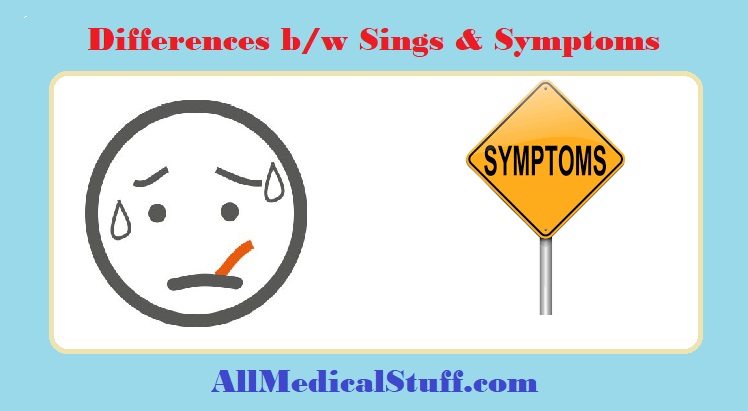In doctors daily routine, two words sign and symptoms are regularly used.
When generally speaking, they are used as synonyms and alternative to each other. But in reality, these two words are totally different and show different things.
Although both of them are very important (and used as well) for diagnosis, but one of them are those feelings that the patient fells while the other ones are those things that some other person (may be a relative or physician) see or examine.
Therefore a good doctor will not only takes proper history and find out different symptoms but will do thorough examinations and find out different signs as well.

So, What are the exact Differences Between Signs And Symptoms?
If you have carefully read the above sentences, you would have already got the main difference. But if you want to learn about them in more detail then continue reading below. I am also going to list some examples so that you can easily understand what signs and symptoms are:
What Are Signs?
Basically signs are objective. They are physical manifestations. The ones that are read or felt by the person other then the patient. It could the relative, the friend or the doctor itself.
So, the moment the patient enters your clinic you must start examination and look for different signs.
There are some signs that are called vital signs. They include, pulse, blood pressure, temperature and breathing rate.
As evident from the above discussion, signs could be noted with your senses directly or can be measured via instrument. Like you can find out the paleness, pulse, redness, injury etc without any instruments. But there are some other signs that cannot be found without the use of medical instruments like blood pressure, blood oxygen level, tachycardia etc.
Yet there are some other types of signs that can be estimated both with instruments and without. Like we can detect hypothermia without any instrument but for quantitative analysis you would then need an thermometer.
Examples Of Signs:
Below i am going to list some signs that would further clear your concepts.
- Tacycardia
- Hyperthermia
- Haematuria
- Temperature
- Blood pressure
- Paleness
- Pulse eximetery
- Breathing rate
- Sinus rhythm
- Fecal occult blood
- Systolic heart murmur
- Lung Volumes
- Stomach rumble
What Are Symptoms?
As i have mentioned in the start, symptoms are those that the patient feels himself. Other people cannot feel them but they can see the signs that arises due to that symptoms.
So, it means that symptoms could give rise to changes in the body that are signs for the examiners.
Symptoms are subjective, which means that the patient will tell you the symptoms. To know about all the symptoms, you would have to take a detailed medical history of the patient as ask different questions so that none of the symptoms is missed.
Normally the patient would tell you that symptoms first which are the most painful or which causes the most discomfort. And he/she may miss the small symptoms that he/she thinks are not important. But for accurate diagnosis you must find out all the symptoms by asking different questions.
So, the importance of symptoms in diagnosis cannot be neglected.
Examples Of Symptoms:
To give you more idea about symptoms, i am adding a few examples so that you can know what questions to be asked while taking history:
- Chest pain
- Discomfort
- Malaise
- Joint pain
- Headache
- Dizziness
- Vomiting
- Back pain
- Should pain
- Jaw pain
- Paleness
Final Words:
So, this was our short guide about the differences between signs and symptoms. Hope you have understand the differences and you will try to find out all the signs and symptoms by taking detailed history and doing complete examination.
Leave a Reply